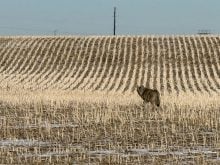PHOENIX, Arizona – After years of dejection, a positive prognosis for the American beef industry has elevated hopes and profits.
“For the first time in 20 years we actually saw an increase in demand,” said Cattlefax analyst Mike Miller.
Last year’s upturn was the first in the demand curve after a 20-year slump. It is attributed to a robust American economy, new beef products and an economic rebound in Asia that improved exports.
“It’s amazing we did what we did,” said analyst Dave Webber.
Read Also

Agritechnica Day 3: Hybrid drive for a combine, data standards keep up to tech change and tractors of the year
Agritechnica 2025 Day 3: Hybrid drive for a combine, data standards keep up to tech change and tractors of the year.
“We had beef production up two and a half percent and saw an increase in wholesale and retail prices.”
The good news was delivered at the National Cattlemen’s Beef Association convention in Phoenix last week, where North American producers shared ideas about marketing, improved beef quality and new products.
In 1999, the American beef sector produced 26.39 billion pounds of beef. It expects to absorb 25.7 billion in 2000.
Demand grew steadily from mid-summer onward for high quality, high-value ribs and loins. This improved demand added an extra $3(U.S.) per hundredweight to the price of a fed steer or heifer sold in the United States.
“We anticipate we should be able to sustain about two-thirds of the demand increase in 2000 that we experienced in 1999,” said analyst Randy Blach.
A decline is expected due to the shorter numbers of beef animals in this segment of the cattle cycle.
One way to increase demand with limited supply is to improve sales of chucks and rounds. However, consumers are still reluctant to buy the end meats and their value remains at 1992 levels.
“One of the big keys to wholesale beef prices over the next several years is if we can gain more consumer acceptance of these primals and see those prices climb,” said Webber.
Cooking instructions were introduced to meat cases in stores last year. Besides providing the anatomical description of a cut, labels also suggested cooking methods. This system has been used in Canada for several years with favorable results.
Hide and offal values are starting to creep up again with renewed interest from Asia. Diminished demand for these had knocked $40 off the price of a finished steer or heifer.
This past year saw the largest feeder calf movement since 1985 as profitability returned for every class of cattle. To fill the pens this season, more lightweights went on feed earlier. They are expected to finish at a lower weight helping the industry move away from record-sized carcasses of the last several years.
Forecasts are favorable across every sector. All forecasts are in American dollars.
Cattlefax predicts the central plains will sell 500 lb. calves for as high as $100 per cwt., while the 750 weights could average $82.
Fat cattle should be worth an average $69 with a range of $65-$75 for the coming year.
Bred cows should fetch around $800 and slaughter cows could edge up past $40 per cwt. These cows should be managed to bring their condition up and produce optimum profit for cow-calf operators.
The wild cards affecting price are availability of cattle, grain prices and the weather.
Cattlefax analysts expect lower feedlot placements from here on because there are fewer stockers available. Extra feeders may be imported.
There is limited ability to bring in feeders from Canada because the animals are staying home for finishing and processing. In addition, Western Canada’s feeding industry has drawn more than 120,000 feeders from Montana to fill the massive capacity in Alberta.
Besides stiff competition for calves, producers must watch the volume and price of feed grains this year.
Extreme drought last year and continued dry conditions this growing season could drive down yields and raise prices. A 50-cent per bushel increase in corn prices could knock $4 per cwt. off the value of a 750 lb. steer.















